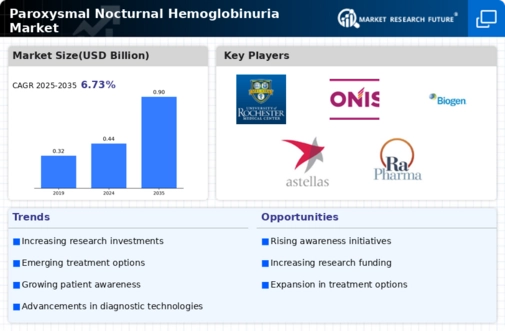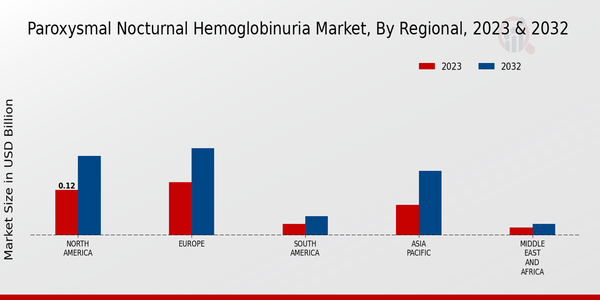Rising Incidence of PNH
The Global Paroxysmal Nocturnal Hemoglobinuria Market Industry is experiencing growth due to the increasing incidence of Paroxysmal Nocturnal Hemoglobinuria (PNH). As awareness of this rare blood disorder rises, more cases are being diagnosed. In 2024, the market is projected to reach 0.44 USD Billion, reflecting the urgent need for effective treatment options. The growing patient population is likely to drive demand for therapies and diagnostic tools, contributing to the overall expansion of the market. This trend suggests that healthcare providers are becoming more adept at recognizing PNH, which may further enhance market growth.
Market Growth Projections
The Global Paroxysmal Nocturnal Hemoglobinuria Market Industry is projected to experience substantial growth over the coming years. With an expected market value of 0.44 USD Billion in 2024, the industry is on track to reach approximately 0.9 USD Billion by 2035. This growth trajectory indicates a compound annual growth rate of 6.68% from 2025 to 2035, driven by factors such as rising incidence rates, advancements in treatment options, and increased awareness among healthcare professionals. The market's expansion reflects a broader commitment to addressing the needs of patients suffering from this rare blood disorder.
Supportive Regulatory Framework
A supportive regulatory environment is fostering growth within the Global Paroxysmal Nocturnal Hemoglobinuria Market Industry. Regulatory agencies are increasingly recognizing the need for expedited approval processes for rare disease treatments, which is beneficial for PNH therapies. This regulatory support not only encourages pharmaceutical companies to invest in research and development but also facilitates quicker access to life-saving treatments for patients. As a result, the market is poised for expansion, with a projected increase in value from 0.44 USD Billion in 2024 to 0.9 USD Billion by 2035, reflecting the positive impact of regulatory initiatives.
Advancements in Treatment Options
Innovations in treatment modalities are significantly influencing the Global Paroxysmal Nocturnal Hemoglobinuria Market Industry. The introduction of novel therapies, such as complement inhibitors, has transformed the management of PNH, leading to improved patient outcomes. These advancements not only enhance the quality of life for patients but also stimulate market growth. As the industry evolves, the market is expected to grow from 0.44 USD Billion in 2024 to approximately 0.9 USD Billion by 2035, indicating a robust demand for innovative treatment solutions. The ongoing research and development efforts in this area are likely to further propel the market forward.
Increased Awareness and Diagnosis
The Global Paroxysmal Nocturnal Hemoglobinuria Market Industry benefits from heightened awareness and improved diagnostic capabilities. As healthcare professionals become more knowledgeable about PNH, the rate of diagnosis is expected to increase, leading to earlier interventions. This trend is crucial, as timely diagnosis can significantly impact patient outcomes and treatment efficacy. The market's growth trajectory suggests that the number of diagnosed cases will rise, thereby expanding the patient base for therapeutic interventions. Consequently, this increased awareness is likely to contribute to the projected compound annual growth rate of 6.68% from 2025 to 2035.
Growing Investment in Rare Disease Research
The Global Paroxysmal Nocturnal Hemoglobinuria Market Industry is witnessing a surge in investment directed towards rare disease research. As stakeholders recognize the unmet medical needs associated with PNH, funding for research initiatives is increasing. This influx of capital is likely to accelerate the development of new therapies and enhance the understanding of the disease. The anticipated growth in the market, with a CAGR of 6.68% from 2025 to 2035, underscores the potential for innovative solutions to emerge from this investment. Such advancements may ultimately lead to improved treatment options and better patient outcomes.
















